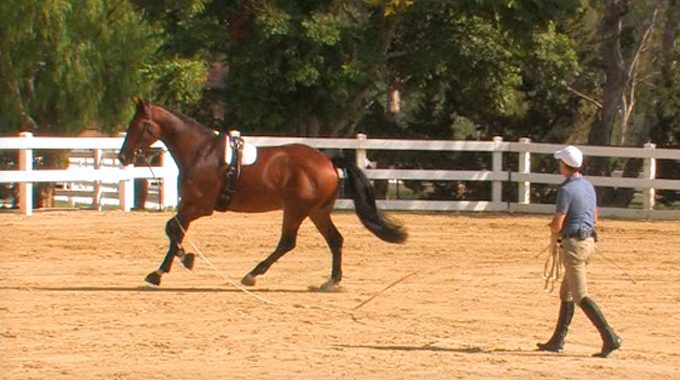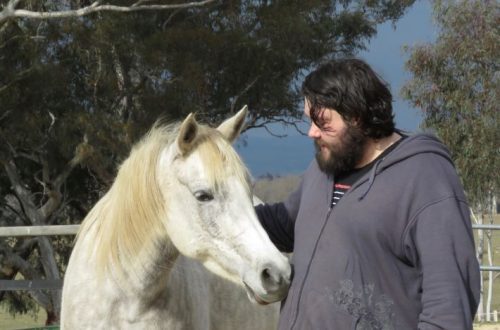
Lunging with a young playful horse
Lunging with a young playful horse
Many horses tend to “let off steam” when working on the lunge. But what if the horse flirts so much that you are no longer in control of the situation? How to build cord workouts with “merry fellows”?
These questions are answered by Olivia Loyacono and Linda Allen.
Olivia:
I love working on the ground, especially with young horses. During cord training, I use a modification of the Parelli method. I am convinced that the use of a rope halter with multiple pressure points and a short (3,65 m) lead can help to achieve better control over the horse.
At the initial stage of training, I actually do not allow any playing along and other fun on the lunge. An already trained horse can play, but only within the time allotted for this. She should not go too far or show aggression.
Start slowly. Before you ask your horse to do anything, try to make sure he is focused on you. Take your time when introducing your horse to the lunge and bridle so as not to frighten him. We need respect, but not fear.
Ask the horse to yield to the pressure (on the front, on the back, on the back pressure on the reins and the pressure down on the back of the head to lower the head). When lunging, give your young horse tasks – try not to allow senseless circles. Perform transitions between gaits, change the direction of movement.
If you constantly challenge your horse with new exercises in a gentle and unobtrusive way (eg, connecting poles), he will learn better, tune in to you as a leader, and focus on your tasks.
Linda:
My experience is that young horses perform best when they have enough time to just “be a horse”, when they can burn off their excess energy during a long stay in the paddock, and not be idle for days in a stall.
The cord work is an indispensable element in the training of a young horse. It is here that she learns respect and trust in a person, gets used to turning to him for guidance. However, a horse overflowing with energy is unlikely to be tuned to work for you. Even a cord and a small barrel may seem to him a longed-for freedom …
Speaking of horse “fun”, remember that safety, both yours and the horse’s, should be at the forefront! Kicking and lunging can have serious consequences, even if your horse is good-natured and did not intend to hurt you at all. It is your responsibility to ensure that your horse never has the opportunity to turn his back on you and put you in a vulnerable position. Proper lunging requires constant, exceptional attention from the lunging line!
Make sure the harness you use on the lunge is effective, safe and comfortable for your horse. The choice is rich: you can use a cavesson, a rope halter, a cord with a chain at the end (the chain is threaded through the halter rings, passing through the nose, and fastens on the ring or on itself in a circle), etc. Make sure the horse is not in pain.
If you prefer a bridle, use only a snaffle iron and always remove the rein (or wrap it around the chinstrap) – do not allow the horse to step into the rein with his foot when he plays along or lowers his head! Pass the cord through the back of the head and attach it to the opposite outer ring of the snaffle. Never attach the line only to the nearest ring of the snaffle – you will overtighten the snaffle in the horse’s mouth, and nothing good will come of it.
Learn to hold the cord in neatly wound loops of such a size that it is impossible to step into and tangle. Fold the loops when you call the horse to you.
Proper lunging involves the ability to control the movement of the horse with the help of a sham-barrier. Some trainers prefer to use the end of the line for this purpose, but I do not find this effective and safe.
Do not be lazy to take small “organizational” breaks in training in order to put everything in order (fold the cord, adjust the ammunition on the horse). Let the horse come to you at your request. So she will understand that your occupation is really serious, that you are in control of the situation, that now is not the time for games.
Pay attention to the size of the circle you are working on. You should be able to reach the horse with a barrage. The circle should not be so big that your horse starts to forget that you are in the center of it. Even if the horse is stagnant or too interested in what is happening around you, you should be able to easily redirect his attention to yourself.
A little fright, perhaps a pair of goats, is acceptable when lunging. But I don’t believe that using cord as a “steam blower” is a good idea. A horse running uncontrollably in circles is at risk of injury. In addition, as a result, you can get a decrease in discipline from your ward.
Always ask the horse to move the way you want, even when the horse is excited. If he wants to gallop, speak to him in a low voice and bend, pulling the end of the line, the head and neck of the horse towards you until he breaks into a trot. Change your gaits and direction frequently as these transitions calm your horse and encourage him to be more attentive to you..
I can not help but mention the use of additional devices. My experience with young horses is that reins (even elastic ones) horses are usually trained to either lean on the snaffle for balance or hide behind the reins. But gog is very useful. It is attached to the girth or to the edge and passes between the front legs of the horse, then passes through the rings of the snaffle, goes up, passes through the rings on the neck strap of the gog and returns to the belt attached to the girth.
This triangular connection allows the horse to experiment freely: raising the occiput forces the nose closer to the chest, and lowering the head allows the nose to stick out. Let your horse determine the position in which he feels freer. Having found it (position “down and in front”), the horse will pull along the top line. Reminder by the barber about the need to involve the butt in the work will help the horse’s back, neck and jaw to relax and become soft. With such work, her muscles will also be strengthened, which will be useful in her further training.
When the horse gets used to the gog, it will be possible to shorten it a little and briefly. Such work is very useful not only for young horses, but also for experienced ones, who, however, cannot properly relax their backs.
Transfer Valeria Smirnova (source).





